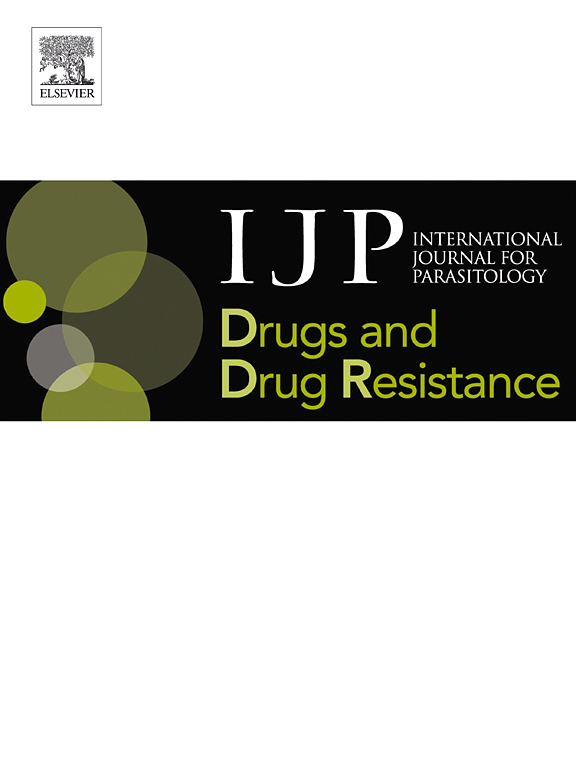Pharmacokinetics and metabolism of artemisinin (ART) in Plasmodium yoelii: ART-heme adduct as a potential biomarker for its resistance
IF 4.1
2区 医学
Q1 PARASITOLOGY
International Journal for Parasitology: Drugs and Drug Resistance
Pub Date : 2025-07-12
DOI:10.1016/j.ijpddr.2025.100603
引用次数: 0
Abstract
Background
Plasmodium falciparum in Southeast Asia and Africa is developing resistance to the antimalarial drug artemisinin (ART). In this study, the metabolite of ART in P. yoelii parasites was evaluated as a potential biomarker for its antimalarial activity as well as its resistance.
Methods
The induced strain of P. yoelii (iPy) was first established after long-time pressure of ART in P. yoelii (Py)-infected mice. The metabolic and pharmacokinetic profiles of ART were then studied in both P. yoelii parasites and infected mice. The pharmacokinetic-pharmacodynamic behaviors of ART in two strains of P. yoelii (Py and iPy) were compared. The pharmacokinetic parameters (e.g., AUC and Cmax) of ART metabolite in parasites were normalized by infected RBC (iRBC) burden.
Results
Lower antimalarial activity was found for ART against iPy than Py, in terms of the 90 % growth inhibitory dose (ED90, 2.9-fold). In contrast with Py, mice infected with iPy could survive for at least 28 days. When ART was orally given to (i)Py-infected mice, ART was detected in parasites as ART-heme adduct. The plasma clearance of ART was not affected by (i)Py-infection, and higher plasma clearance of ART (by 3-4-fold) was found after multiple doses. After being normalized by iRBC, the exposure of ART-heme in P. yoelii parasites was dose-dependent, and its maximum concentration (Cmax) was reached at 3–5 h. Compared with Py parasites, lower iRBC-normalized exposure of ART-heme (AUC0-t, normalized) was found in iPy parasites (61.1 % of Py parasites) after an oral dose of ART to infected mice.
Conclusions
Plasma ART concentration merely reflected drug exposure in the host. ART-heme adduct was the major metabolite for ART in P. yoelii parasites, and it could be a potential biomarker for the antimalarial activity of ART as well as its resistance.

青蒿素(ART)在约氏疟原虫体内的药代动力学和代谢:ART血红素加合物作为其耐药性的潜在生物标志物
背景东南亚和非洲的恶性疟原虫正在对抗疟药物青蒿素(ART)产生耐药性。在本研究中,对ART在P. yoelii寄生虫中的代谢物进行了评估,作为其抗疟活性和耐药性的潜在生物标志物。方法在感染约氏疟原虫(Py)的小鼠体内,经长时间抗逆转录病毒(ART)压力,首次建立约氏疟原虫(iPy)诱导菌株。研究了ART在约尔氏疟原虫和感染小鼠体内的代谢和药代动力学特征。比较了ART在两株约氏疟原虫(Py和iPy)中的药动学-药效学行为。寄生虫体内ART代谢物的药代动力学参数(如AUC和Cmax)在感染红细胞(iRBC)负荷下归一化。结果以90%生长抑制剂量(ED90, 2.9倍)计算,ART对iPy的抗疟活性低于Py。与Py相比,感染iPy的小鼠至少可以存活28天。当口服ART给(i) py感染小鼠时,在寄生虫中检测到ART作为ART血红素加合物。(1) py感染不影响抗逆转录病毒的血浆清除率,多次给药后发现抗逆转录病毒的血浆清除率更高(3-4倍)。经iRBC归一化后,约氏疟原虫体内ART-血红素暴露量呈剂量依赖性,在3-5 h达到最大浓度(Cmax)。与Py寄生虫相比,经口服ART给药感染小鼠后,iPy寄生虫体内ART-血红素(AUC0-t,归一化)暴露量较Py寄生虫低(占Py寄生虫的61.1%)。结论血浆ART浓度仅反映宿主药物暴露情况。ART血红素加合物是约氏疟原虫中ART的主要代谢物,可作为ART抗疟活性和耐药性的潜在生物标志物。
本文章由计算机程序翻译,如有差异,请以英文原文为准。
求助全文
约1分钟内获得全文
求助全文
来源期刊

International Journal for Parasitology: Drugs and Drug Resistance
PARASITOLOGY-PHARMACOLOGY & PHARMACY
CiteScore
7.90
自引率
7.50%
发文量
31
审稿时长
48 days
期刊介绍:
The International Journal for Parasitology – Drugs and Drug Resistance is one of a series of specialist, open access journals launched by the International Journal for Parasitology. It publishes the results of original research in the area of anti-parasite drug identification, development and evaluation, and parasite drug resistance. The journal also covers research into natural products as anti-parasitic agents, and bioactive parasite products. Studies can be aimed at unicellular or multicellular parasites of human or veterinary importance.
 求助内容:
求助内容: 应助结果提醒方式:
应助结果提醒方式:


